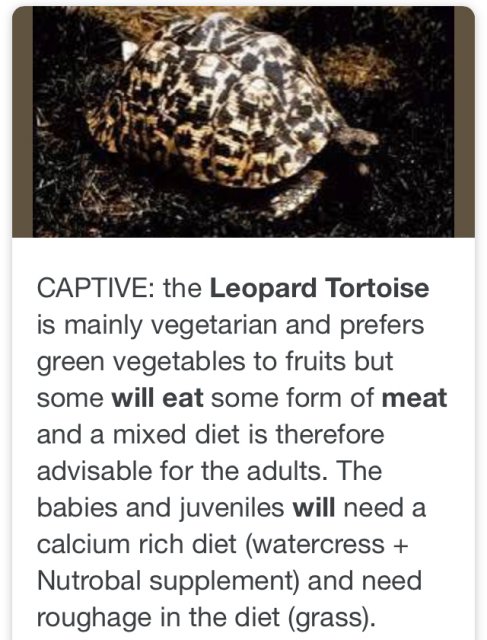Would recommend crickets, softer and easier to digest.I don’t see these guys catching any live insects would you recommend occasionally giving freeze dried mealworms or crickets?
Leopard tortoise pyramiding
- Thread starter weston
- Start date
Would recommend crickets, softer and easier to digest.I don’t see these guys catching any live insects would you recommend occasionally giving freeze dried mealworms or crickets?
I'll simplify that, they can eat chicken in small amounts , but should never be fed beef or pork.I’ve since read not to give these guys any animal proteins. Any other ideas?
What is this based on? any specific reason? any papers to back up why beef or pork is bad but chicken is okay for S. pardalis, or any chelonians?I'll simplify that, they can eat chicken in small amounts , but should never be fed beef or pork.
What's the humidity and how are you measuring it? Humidity levels have been linked to pyramiding, and young tortoises should be kept fairly humid to begin.Help!!! I’ve got a problem, well I think I’ve got a problem.. my one leopard looks perfect he’s alittle high domed but no signs of anything wrong with his shell his growth rings are coming in smooth and he’s gaining a lot of new White coloration I’m seeing in his shell for the first time. My other leopard has gained no to very little white in his shell. His growth rings are a dark color and looked to be raised almost engulfing his smaller hatchling scutes. They are both in the same enclosure and eating great both are soaked daily and seem energetic what’s wrong with my one Leo’s shell??
Any pictures of the tortoises or the enclosure?
What's the basking spot temperature and how are you measuring it?Feeding a mixture of collard greens, kale, and other leafy greens, natural grasses + weeds (I don’t use pesticides) and their mazuri pellet diet. I soak pellets first so they can eat them easily, also they are under a fairly new ReptiSun 10.0 UVB and a 80 Watt heat lamp
If they'll use it. I've seen many completely ignore it. Dusting with calcium may be more effective.Do they have cuttlebone to chew on? Helps torts get more calcium
Fast growth does not equal a healthier animal. People can get retics up to ridiculous lengths within the first year, but it usually results in obese animals that don't live as long. Feed a proper diet, provide proper temps/humidity and the animals will grow at the rate their body allows.’m sorry to change up my questions now but also how can I help these guys grow faster I feel like they are way behind the size they should be!!!
I doub't this would cause faster growth (unless they aren't in the "proper" conditions currently).As far as faster growth,I would keep them in a outdoor pen during the warm months, this allows them to eat weeds,get plenty of exercise and a good dose of sunlight, just make sure the pen is escape proof
They still need protein (amino acids are required to function), but they require significantly lower levels than omnivores or carnivores. The plants provide more than enough if a "proper" diet is given.I know protein isn’t required for these guys like it is recommended for redfoots. Would giving them a option to have some cause any harm if I did so in moderation? I just don’t know why these guys aren’t growing!!
For leopards or redfoots? S. pardalis is an opportunistic herbivore and should not be given vertebrates/invertebrates in captivity, let alone every other day.A little protein may help, I recommend a mix of chicken (cooked) and insects, a couple bites each every other day is plenty
They have been observed eating carcass, bone, ash, inorganic material and feces (see here, here, here, and here); however this is not uncommon in herbivores during periods of low food availability in order to get some sort of nutrients (see here (page 28), here, and here).
Do not feed your leopards invertebrates. Keep the diet to grasses, vegetables, and weeds. Make sure it's all lower in (or doesn't contain) oxalic acid & goitrogens, has a good Calcium: Phosphorous ratio (1.5:1 — 2:1), and is high in fibre.I don’t see these guys catching any live insects would you recommend occasionally giving freeze dried mealworms or crickets?
Ok, thank you to start with! I’m gonna have to break this down into sections to get back to you on everything you asked so please bear with me as I have a lot to type out and I’d actually love to hear you have to say. You seem very knowledgeable about these tortoises.
1. I didn’t think they were supposed to receive any meat proteins but I’m just wondering if anyone has figured out a way or has been doing something differently then myself to help there tortoises pack on some size. I’m not concerned with growing them out fast or having giant leopard tortoises but I’d like to know my animals are healthy and size is one of the few measurements I can use to make sure they are growing correctly and receiving everything they need. My two leopards are 6 months now and the larger of the two is only around 3 inches the other is closer to 2.5 inches I’m not sure they are unhealthy as they seem very active and eat like pigs but other people who have these are claiming there 6 month old tortoises to be 4-5 inches and growing much faster then my own.
2. I’ve been monitoring the humidity in there enclosure using a humidity gauge I had left over from my old bearded dragons setup it’s nothing fancy but I figured it should do the trick I aim to keep the humidity levels around 60-70% but they also have sphagnum moss available to them under their log hide so there is super humid area they can go to if they decide to self regulate and seek out higher humidity levels. Also unfortunately I don’t have pictures of my two or there enclosure at this time but I should be able to provide some this evening if you’d like just let me know and I’ll post some.
3. I’m using the same style temp gauge as my humidity gauge they aren’t the best just what I had lying around, I keep the basking spot around 90* with the rest of the enclosure in the 80’s possibly upper 70’s at night. I used to move the gauge around in the enclosure to check but I messed up the adhesive since and had to take it out all together recently.
4. As far as the cuttlebone they haven’t shown any interest whatsoever but I’ve made sure to dust there food more frequently than usual I decided to set my calcium powder in plain sight on top there enclosure so I don’t forget.
5./6. I think I explained most of these two or provided info already but if not please let me know what else you have questions about and I’ll get back to you with a response.
7./8. I’m feeding my tortoises a very balanced diet from what I’ve found online they readily have a variety of fresh greens and veggies available to them as well and naturally sourced weeds and grasses I even occasionally provide them with different hays and there tortoise pellet diet I buy as well. I personally looked into adding the insects into their diet after reading the response left and while it won’t kill the tortoise I decided against it before reading this and didn’t pick anything up (crickets or mealworms) to add to there diet.
1. I didn’t think they were supposed to receive any meat proteins but I’m just wondering if anyone has figured out a way or has been doing something differently then myself to help there tortoises pack on some size. I’m not concerned with growing them out fast or having giant leopard tortoises but I’d like to know my animals are healthy and size is one of the few measurements I can use to make sure they are growing correctly and receiving everything they need. My two leopards are 6 months now and the larger of the two is only around 3 inches the other is closer to 2.5 inches I’m not sure they are unhealthy as they seem very active and eat like pigs but other people who have these are claiming there 6 month old tortoises to be 4-5 inches and growing much faster then my own.
2. I’ve been monitoring the humidity in there enclosure using a humidity gauge I had left over from my old bearded dragons setup it’s nothing fancy but I figured it should do the trick I aim to keep the humidity levels around 60-70% but they also have sphagnum moss available to them under their log hide so there is super humid area they can go to if they decide to self regulate and seek out higher humidity levels. Also unfortunately I don’t have pictures of my two or there enclosure at this time but I should be able to provide some this evening if you’d like just let me know and I’ll post some.
3. I’m using the same style temp gauge as my humidity gauge they aren’t the best just what I had lying around, I keep the basking spot around 90* with the rest of the enclosure in the 80’s possibly upper 70’s at night. I used to move the gauge around in the enclosure to check but I messed up the adhesive since and had to take it out all together recently.
4. As far as the cuttlebone they haven’t shown any interest whatsoever but I’ve made sure to dust there food more frequently than usual I decided to set my calcium powder in plain sight on top there enclosure so I don’t forget.
5./6. I think I explained most of these two or provided info already but if not please let me know what else you have questions about and I’ll get back to you with a response.
7./8. I’m feeding my tortoises a very balanced diet from what I’ve found online they readily have a variety of fresh greens and veggies available to them as well and naturally sourced weeds and grasses I even occasionally provide them with different hays and there tortoise pellet diet I buy as well. I personally looked into adding the insects into their diet after reading the response left and while it won’t kill the tortoise I decided against it before reading this and didn’t pick anything up (crickets or mealworms) to add to there diet.
Just a FYI I’ve sense swapped out lights and changed there position. They are now hanging above the tortoises more centered in the enclosure. I also just picked up a new digital humidity/temperature gauge today seems like my old ones weren’t giving me correct readings on the opposite end of the tortoise table I’m getting a reading of 79% humidity and 84*F directly under the heat lamp is reading 93*F are these readings good?
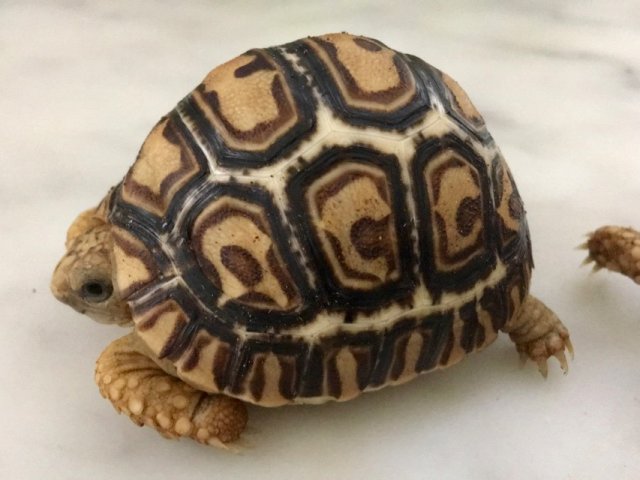
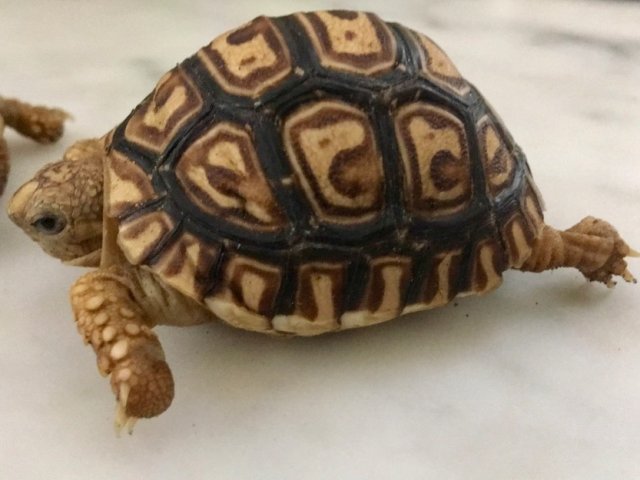
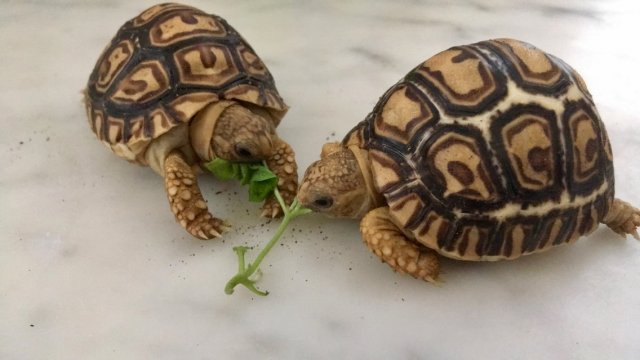
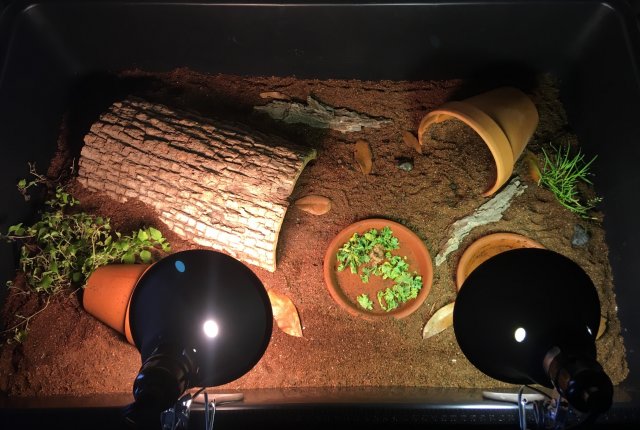




What is this based on? any specific reason? any papers to back up why beef or pork is bad but chicken is okay for S. pardalis, or any chelonians?
What's the humidity and how are you measuring it? Humidity levels have been linked to pyramiding, and young tortoises should be kept fairly humid to begin.
Any pictures of the tortoises or the enclosure?
What's the basking spot temperature and how are you measuring it?
If they'll use it. I've seen many completely ignore it. Dusting with calcium may be more effective.
Fast growth does not equal a healthier animal. People can get retics up to ridiculous lengths within the first year, but it usually results in obese animals that don't live as long. Feed a proper diet, provide proper temps/humidity and the animals will grow at the rate their body allows.
I doub't this would cause faster growth (unless they aren't in the "proper" conditions currently).
They still need protein (amino acids are required to function), but they require significantly lower levels than omnivores or carnivores. The plants provide more than enough if a "proper" diet is given.
For leopards or redfoots? S. pardalis is an opportunistic herbivore and should not be given vertebrates/invertebrates in captivity, let alone every other day.
They have been observed eating carcass, bone, ash, inorganic material and feces (see here, here, here, and here); however this is not uncommon in herbivores during periods of low food availability in order to get some sort of nutrients (see here (page 28), here, and here).
Do not feed your leopards invertebrates. Keep the diet to grasses, vegetables, and weeds. Make sure it's all lower in (or doesn't contain) oxalic acid & goitrogens, has a good Calcium: Phosphorous ratio (1.5:1 — 2:1), and is high in fibre.
The more domed of the two with white on his shell isn’t the one I’m worried about with the pyramiding, his shell is almost perfectly smooth and I’ve seen some recent growth out of him. However they are both still very small for there age from what I’ve seen online, any Opinions?I'll simplify that, they can eat chicken in small amounts , but should never be fed beef or pork.
Humidity is a bit high.The more domed of the two with white on his shell isn’t the one I’m worried about with the pyramiding, his shell is almost perfectly smooth and I’ve seen some recent growth out of him. However they are both still very small for there age from what I’ve seen online, any Opinions?
What is this based on? any specific reason? any papers to back up why beef or pork is bad but chicken is okay for S. pardalis, or any chelonians?
Many of my old neighbors used to (and still do) kept them, I'm basing my diet on what seems to work best, a mostly vegetable diet supplemented with an ocassional bite of chicken has worked for these big guys for several decades, and they exhibit well proportioned and formed shells and good body mass, the ones raised outdoors when small grew faster, perhaps due to either better uvb rays from sunlight, or more exercise promoting better digestion and metabolism, currently (eyeballing from last time I saw them) I'd put most of them between 40 and upper 50s lb range, they are more common as pets here with the warmer climate


